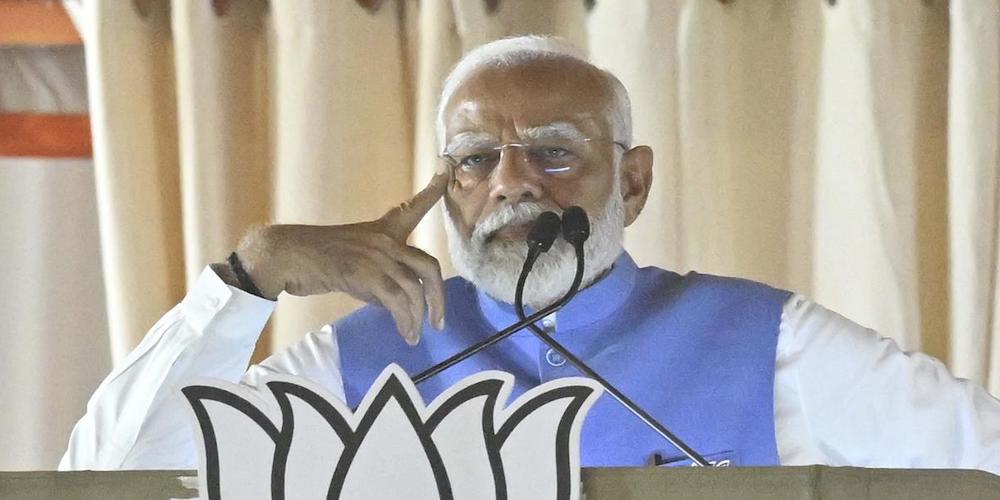RIGHT ANGLE – Evaluating Narendra Modi’s Election Results

How does one view the results of the just concluded General Elections?
Well, it is like a glass half full of water. It depends on the person how he or she describes the situation. The one positively inclined will emphasise the water –content, whereas the fault – finder will point out the half-emptiness in the glass.
Similarly, for supporters and sympathisers of the Bharatiya Janata Party (BJP), there are quite a few pluses in this round of elections in India.
One, under the leadership of Prime Minister Narendra Modi, the BJP-led National Democratic Alliance (NDA) has won three consecutive elections, equaling the record of the Congress stalwart and India’s first Prime Minister Jawaharlal Nehru. It is not a small achievement by any means.
Two, with 240 MPs his BJP has lost the magic figure of 272 to claim the majority on its own, and thus now critically dependent on the NDA allies like the Telugu Desam and Janata Dal (U), both of which have not been exactly trusted partners in the past, but the fact remains that the BJP’s number (240) is still six (6) more than the combined total of nearly 40 partners in the opposition INDIA alliance (234).
Three, Assembly elections in three states that were held simultaneously along with the general elections saw the ruling NDA emerging triumphant in all of them – Sikkim, Arunachal Pradesh and Odisha. Arunachal and Odisha were won by the BJP singlehandedly. In fact, the victory in Odisha with 20 out of 21 Lok Sabha seats and dethroning the country’s longest-serving state government led by Naveen Patnaik for over 25 years is nothing less than unprecedented. The BJP is now going to be the sole governing party of the eastern state. It is a feather in the cap of Modi in whose name the people of Odisha really voted.
Four, by bagging seats in Andhra Pradesh, improving the party tally to be equal with the ruling Congress in Telangana, registering an appreciable rise in the party’s vote share in Tamil Nadu, defending the position as the leading party in terms of the seats in the Lok Sabha in the state of Karnataka that is under a very powerful Congress government , and by making the maiden entry in Kerala and sending a member to the parliament, the BJP under Modi has proved that its influence is no longer confined to the north, central and western India. In fact, the BJP is now the only national party that has presence in all parts of the country.
And now the minuses:
One, though there is no doubt that though Modi remains the most popular leader of the country, there has been a big dent in the Modi – charisma. The significant fall in his victory margin in Varanasi, his parliamentary constituency (from nearly four lakhs in 2019 to only about 1.5 lakh in 2024), is the proof of that. There are merits if some people now say that Modi’s “aura of invincibility” has been shattered in this year’s Lok Sabha polls.
Two, more than anything else, the drastic fall in the party number of 303 from 2019 to 240 in 2024, is the unexceptional performance in Uttar Pradesh, Modi’s “political home state”, where there is a very strong and popular chief minister in Yogi Adityanath and which houses the magnificent Ram temple that has been newly built in the birth place of Lord Ram that housed the disputed Babri Masjid, let alone the dazzling infrastructures that Modi has built in the last 10 years in what is the politically the most important state of the country that sends 80 MPs to the Lok Sabha.
Three, if Modi in the last 10 years had taken some spectacular out of box and visionary decisions such as demonetisation, digital payments, military-reforms, criminalisation of triple-talaq and abrogation of the Article 370 that had kept Kashmir out of the national mainstream ever since our independence, these were possible precisely because of the fact that the BJP on its own had the magic figure of 272. It enabled the lead party of the NDA and its leaders to be less prone to blackmail and compromises as far as the survival of the Modi government was government. This stability of the new government of the country is now gone. Modi would have to carry out or perform what is said to be “coalition Dharma” and indulge in hard negotiations with the coalition partners on important issues for consensus before initiating any major legislation or reform. Maybe he has to go by what could be “a minimum programme” of the coalition that in every likelihood will avoid Modi’s promised measures like one-nation-one poll and uniform civil code. Of course, it is a different matter that many liberals view a weak and coalition government at the Centre in India is ideal for a country of such diversities, though that is a highly debatable proposition.

Now the question arises as to what the reasons behind such a downfall for Modi are. Even though a winner in saving the government for the rare third term, Modi is perceived widely, both inside and outside the country, as the biggest loser of the 2024 poll. One may attempt to find out some of these reasons.
One, Modi, arguably the greatest political communicator that this country has produced in recent memory, failed to communicate with the same force and clarity his achievements and proposed schemes as was the case in 2019 and 2014. Unlike the previous occasions, Modi’s speeches did not sound inspiring enough. They did not generate the same enthusiasm. Modi in 2024 was not the same communicator that he was in 2014 and 2019. In fact, there are merits in the arguments that the languages in some of his speeches this time did not behove of a prime minister. His overemphasis on the fear of a particular community (Muslims) taking away the fruits of the reservation or for that matter nation’s resources for the poor if the opposition INDIA alliance assumed power was perhaps avoidable. It not only led to consolidation of the Muslims in voting Modi out in states like Uttar Pradesh and West Bengal, where the BJP was expected to perform very high but also alienated the urban -educated urban, many of whom were his erstwhile supporters.
Secondly, in the Presidential style of campaigning all over the country that is his USP, his efforts failed this time in countering the narratives of the opposition, particularly that of the Congress leader Rahul Gandhi, that Modi would be changing the constitution and do away with the reservations for the OBC, Scheduled castes and Tribes and that Modi is transferring all the national wealth to a select group of industrialists. This explains why there was a significant fall in the votes for the BJP from the Dalits, Tribes and OBCs in the Hindi-heartland like Uttar Pradesh and Rajasthan, the party’s traditional strongholds. And what is noticeable here, these charges against Modi were sheer and manufactured lies having no basis whatsoever. But Modi could not eliminate such doubts among the voters’ minds.
Thirdly, in the absence of effective and equally articulate party colleagues, Modi alone was not sufficient to highlight his government’s significant achievements to the people. Even the manufactured charges of corruption against the government were not countered effectively. For instance, take the case of electoral bonds. Rahul Gandhi and other opposition leaders went hyper in pointing out how the BJP got the illegal funding by the corporates, but hardly anyone in the BJP countered this charge in the public rallies by asking the Congress who were the corporate houses that bought electoral bonds for the Congress worth over a thousand crores.
Fourthly, there is enough evidence to suggest that this is perhaps the Indian election where the foreign interference was of a great intensity, directly and indirectly, in working against the Modi government and for the Congress party. This interference was in the form of building dubious and mostly false narratives against the government in foreign and social media outlets. Many leading foreign NGOs did fund liberally in building these anti-Modi and anti-Hindu narratives. On social media, Modi and the BJP got the worst possible coverage. Some foreign governments even did intervene directly by describing many of the Modi government’s actions as undemocratic and communal. Modi or for that matter the BJP failed miserably in tackling such accusations.
Finally, Modi’s assertion that the NDA would get more than 400 seats, with his own BJP bagging as many as 370 proved, in retrospect, most unwise. It gave unnecessary scope to the speculations that Modi was trying to change the constitution with such a big mandate. But more than anything else, this assertion of “Beyond 400” was not a sign of confidence. It was perceived, and rightly so, to be a reflection of arrogance.
Voters everywhere like to be pampered, not ordered. “Beyond 400” was perceived to be an order, not a request or appeal. In my humble view, this “order” must have cost Modi thousands of votes.


